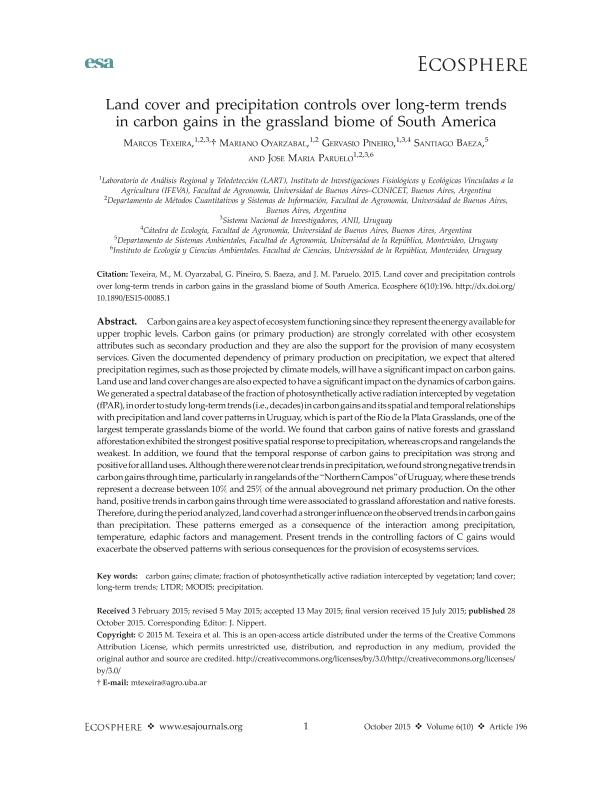Artículo
Land cover and precipitation controls over long-term trends in carbon gains in the grassland biome of South America
Texeira González, Marcos Alexis ; Oyarzabal, Mariano
; Oyarzabal, Mariano ; Piñeiro, Gervasio
; Piñeiro, Gervasio ; Baeza, Santiago; Paruelo, José
; Baeza, Santiago; Paruelo, José
 ; Oyarzabal, Mariano
; Oyarzabal, Mariano ; Piñeiro, Gervasio
; Piñeiro, Gervasio ; Baeza, Santiago; Paruelo, José
; Baeza, Santiago; Paruelo, José
Fecha de publicación:
10/2015
Editorial:
Ecological Society of America
Revista:
Ecosphere
ISSN:
2150-8925
Idioma:
Inglés
Tipo de recurso:
Artículo publicado
Clasificación temática:
Resumen
Carbon gains are a key aspect of ecosystem functioning since they represent the energy available for upper trophic levels. Carbon gains (or primary production) are strongly correlated with other ecosystem attributes such as secondary production and they are also the support for the provision of many ecosystem services. Given the documented dependency of primary production on precipitation, we expect that altered precipitation regimes, such as those projected by climate models, will have a significant impact on carbon gains. Land use and land cover changes are also expected to have a significant impact on the dynamics of carbon gains. We generated a spectral database of the fraction of photosynthetically active radiation intercepted by vegetation (fPAR), in order to study long-term trends (i.e., decades) in carbon gains and its spatial and temporal relationships with precipitation and land cover patterns in Uruguay, which is part of the Rio de la Plata Grasslands, one of the largest temperate grasslands biome of the world. We found that carbon gains of native forests and grassland afforestation exhibited the strongest positive spatial response to precipitation, whereas crops and rangelands the weakest. In addition, we found that the temporal response of carbon gains to precipitation was strong and positive for all land uses. Although there were not clear trends in precipitation, we found strong negative trends in carbon gains through time, particularly in rangelands of the "Northern Campos" of Uruguay, where these trends represent a decrease between 10% and 25% of the annual aboveground net primary production. On the other hand, positive trends in carbon gains through time were associated to grassland afforestation and native forests. Therefore, during the period analyzed, land cover had a stronger influence on the observed trends in carbon gains than precipitation. These patterns emerged as a consequence of the interaction among precipitation, temperature, edaphic factors and management. Present trends in the controlling factors of C gains would exacerbate the observed patterns with serious consequences for the provision of ecosystems services.
Archivos asociados
Licencia
Identificadores
Colecciones
Articulos(IFEVA)
Articulos de INST.D/INV.FISIOLOGICAS Y ECO.VINCULADAS A L/AGRIC
Articulos de INST.D/INV.FISIOLOGICAS Y ECO.VINCULADAS A L/AGRIC
Citación
Texeira González, Marcos Alexis; Oyarzabal, Mariano; Piñeiro, Gervasio; Baeza, Santiago; Paruelo, José; Land cover and precipitation controls over long-term trends in carbon gains in the grassland biome of South America; Ecological Society of America; Ecosphere; 6; 10; 10-2015; 1-21; 196
Compartir
Altmétricas



